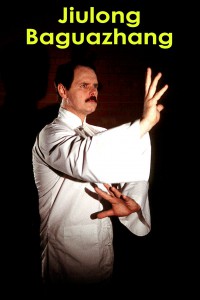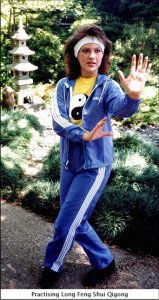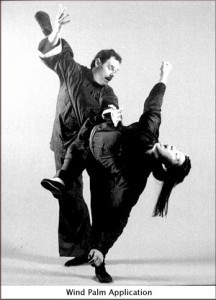 What is Jiulong Baguazhang™?
What is Jiulong Baguazhang™?
Jiulong Baguazhang™ is also known as Nine Dragon Eight Diagram Palm. This Chinese internal style is part of the Li family Daoqiquan system. It is a rare almost extinct family system of Baguazhang believed to have been conceived by Daoist sage Li, Ching-Yuen. He claimed to have learned this method along with Daoyin Chinese yoga from a Daoist monk in the Emei Mountains of China. It was passed down to his cousin Li, Zhang-Lai of Sichuan province and then to his son Li, Longdao (Frank Li) who escaped the communist regime and moved to the United States where he imparted the art to John Painter through a 20 year apprenticeship.
Jiulong Qigong Health and Boxing Art
The ultimate goal of this particular style of Chinese internal health and martial art is wholistic in nature. Jiulong Baguazhang™ is used to increase health and longevity. As a martial art it trains the mind and body to move naturally with such power, grace and balance that, no matter what happens, one is able to go along with the now moment. The student learns to flow smoothly in circles, his mind and body merging and emerging with external forces while preserving his own energy. It is this spontaneity of action and continuity of change that is responsible for the remarkable longevity and martial power of its students. To be one with the Dao, to flow with nature is the objective of Jiulong Baguazhang™ practice.
Master Li, Ching-Yuen claimed that this system of Baguazhang opened up the doorway to internal energy or Qi by establishing a relationship of kinetic physical postures to mental attitudes which in turn created immense natural Jin (power) and Qi energy for health and self-defence. When this method was demonstrated to the Late Master Jou, Tsung-Hwa author of Dao of the Yijing and Dao of Meditation he was amazed at the depth of the system and declared. “Dr. John Painter is the only person I have met in any country who truly understands the lost connection of Baguazhang to the Yijing. This information is all lost in China today. It must be restored. I hope he will share this art with all who want better health and great internal power.”
Nine Dragon From Natural Methods
Li Ching-Yuen’s Nine Dragon Baguazhang™ art consists of learning how to utilize a series of palms or upper body positions and eight stances or stepping patterns for the lower body as special exercises to stimulate internal energy for health and martial power. Posture and stance creates a shape or mind body energy receptacle. There are eight primary shapes corresponding with the eight mother Gua of the Yijing trigrams found in the ancient Chinese texts. Each of the Yijing trigrams are associated with numerous types of energy found in nature and expressed as yin or yang. These energies may stimulate or tonify sinews, muscles, internal organs, moods, circulation of blood and Qi or other associations.
Baguazhang students assume the shape (palm) associated with a particular Gua while exercising. Most often this is done walking in a circular pattern each shape and movement within the shape reflect the philosophy and attitude of the trigram to which it is assigned. So over time it becomes linked in mind, body and spirit with the Gua association. As the Chinese saying goes, “The mind commands, the body moves and the Qi follows.” when the mind stimulates the body by using these images linked to physical action a wondrous connection between the internal and external forces of our mind, nature and universal energy can be achieved.
Basic training for Nine Dragon Baguazhang™: Two Main Sections
One section is called the Jiankang (physical health art). This is a Qigong, internal training to develop tranquillity, longevity and health.
The second section is the Zhandouli or combat effective practice. The art has its own brand of martial Qigong training to create internal power and strength known as Wuyi Gong training in the internal martial skills. Zhandouli training is long and rigorous both mentally and physically, as this is one of the few “complete” Chinese internal martial arts left in the world today.
 Jiankang Bagua Qigong
Jiankang Bagua Qigong
This section of the art contains the longevity meditations and exercises of the Flying Dragon Qigong, The Nine Healing Circles Bagua Qigong and Long Feng Shui Bagua Qigong these Longwudao (dragon dances) were reputedly used by Li, Ching-Yuen to attain the age of well over 100 years in perfect health.
Students learn how to circulate internal energy through the acupuncture meridians and create internal connections for specific power points to stimulate a tranquil mind and improve strength and health. Training begins with Standing meditations, Qigong visualization and breathing exercises and proceeds to linear forms then to walking the circle flowing through the eight stances and palm postures. Each posture can be used to generate its own special brand of healing and harmonizing Qi. This Qi energy relates to the acupuncture meridians associated with the specific Gua in the Yijing, the time of day and seasons. Students on this path report that the postures can be used for healing just as in acupuncture and massage simply by walking the circle and holding or changing postures relating to the Qi flow needed for healing. After Qigong health practices the student can choose to move on to study Baguazhang Zhandouli.
Zhandouli Combat Baguazhang
All students of martial Baguazhang begin with Wuyi Kaimen a type of martial yoga for opening the joints and improving flexibility. Next comes Wuyi Qigong (martial skill internal training). This begins with standing forms or Yizhang (mind palm) to release binding tension and stress.
After these exercises to develop root and whole body movement are undertaken, each posture is examined as to its particular traits and associations with physical alignments and the Yijing mental images for creating Jin or bio-mechanical force. This is done in standing forms, then linear forms and finally in circle walking forms.
No Fixed Forms
Unlike other styles where students memorize hundreds of fixed dance like forms, Li Ching-Yuen’s Nine Dragon Baguazhang™ methods in Zhandouli stages have no long elaborate fixed forms (kata) in the traditional sense. This is because in real combat a specific combination of techniques as practiced in a form seldom arises in just the precisely memorized sequence. A true martial artist must learn to adapt and flow with what is happening and not repeat a series of memorized actions.
The methods of learning combative tactics in Jiulong Baguazhang™ is at first to start walking the circle holding the postures and visualizing the image of the associated Gua to create a mind energy link. This is like Zhan Zhuang standing practice, only while circle walking. Later one learns to change from one posture to another matching the flow of movement, stepping and turning of the body with the changing of the palms to create tremendous whole body force or Jin. In this way the postures become paths of energy movement, permeating the total psychological and physiological makeup of the student.
Zhuang standing practice, only while circle walking. Later one learns to change from one posture to another matching the flow of movement, stepping and turning of the body with the changing of the palms to create tremendous whole body force or Jin. In this way the postures become paths of energy movement, permeating the total psychological and physiological makeup of the student.
Now the student is ready to walk and change visualizing one or more imaginary opponents attacking from different angles. The goal here is to use the changes, turns, spins and flexibility to evade, strike, throw and lock the phantom opponents while walking around and through the circle. The practice now resembles a standard martial art Baguazhang form except this form evolves and changes each time it is practiced. Beginners do this at a very slow pace paying attention to matching stepping with body and arm actions.
In advanced stages, Jiulong Baguazhang™ experts move with blinding speed, circling in and out of one to nine circles or posts until the student can easily and rapidly weave in and out of the nine posts like a hawk pursuing a swallow. Mr. Li often said, ” A form is merely a collection of principles expressed as a pantomime of real combat. You just do it at first in slow motion and then faster. If you memorize set routines you will always be surprised by your opponents unexpected moves. When your Yi (imagination) is strong you can create thousands of patterns.”
Jiulong Baguazhang™: A Complete Martial Art
Combat tactics, power sensing and emitting energies, pressure points, pushing hands, light body skills, iron shirt Qigong training, internal iron palm and applications practice for striking, locking and throwing with each palm are all part of this study of each posture. In essence one may say that there are actually eight separate martial art methods in Jiulong Baguazhang™, Heaven boxing, Earth boxing, Fire boxing, Water boxing, Thunder boxing, Wind boxing, Lake boxing and Mountain boxing.
When one has achieved proficiency in all eight styles the practice evolves in to combining the styles with each other in 64 basic combinations. As that skill becomes natural the student can now be called a Long Zhanshi (Dragon warrior). Here push hands games, practical applications and work on balance beams and elevated posts are practiced.
In the martial or Zhandouli side, one learns how the postures connect to produce Jin force. As one continues and comprehends the changing of a single palm through the positive yang and negative yin aspects of each individual palm, he is said to have achieved Yi Zhang De (the virtue of one palm). These are known as the Dragon Gates and the student has passed through one of the Ba long men, eight dragon gates.
After all eight postures are absorbed through circle walking exercises, the martial Jin of each understood the student possesses Baguazhang De, (eight forms of palm virtue). The word De is used here instead of Gong (skill) as in Chinese De means something experienced with the Xin or heart and mind. In other words it is understood intuitively not just mechanically.
After the palms for each of the eight gates are completed, one begins to move to the highest level. In this level, movement begins to spontaneously generate forms from the unconscious while circle walking. As a student comes to trust his inner senses his baguazhang movements begin to exist on a subjective level, coming and going as naturally as any other habitual activity. At this stage Nine Dragon Baguazhang™ becomes a spontaneous and creative health and martial exercise with no fixed routine or conditions. When a student reaches this level he has passed though the ninth dragon gate. He or she has evolved into the realm of the Ninth Dragon the ultimate state of Wuwei or spontaneous harmony with natural law.
If you would like to find out more about Jiulong Baguazhang and would like to talk with other students of this martial art, about the art, then you might want to consider joining our Jiulong Baguazhang Facebook Group. Click below to join.
